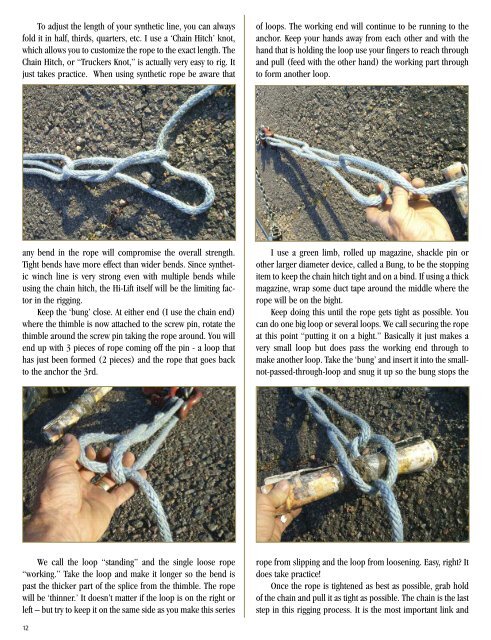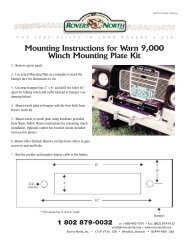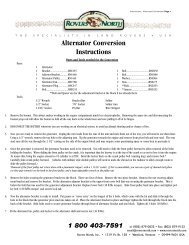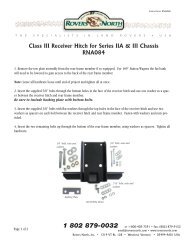Fam ily o w n ed b y en th u siasts sin ce 19 7 9
Fam ily o w n ed b y en th u siasts sin ce 19 7 9
Fam ily o w n ed b y en th u siasts sin ce 19 7 9
Create successful ePaper yourself
Turn your PDF publications into a flip-book with our unique Google optimized e-Paper software.
To adjust <strong>th</strong>e l<strong>en</strong>g<strong>th</strong> of your syn<strong>th</strong>etic line, you can always<br />
fold it in half, <strong>th</strong>irds, quarters, etc. I use a ‘Chain Hitch’ knot,<br />
which allows you to customize <strong>th</strong>e rope to <strong>th</strong>e exact l<strong>en</strong>g<strong>th</strong>. The<br />
Chain Hitch, or “Truckers Knot,” is actually very easy to rig. It<br />
just takes practi<strong>ce</strong>. Wh<strong>en</strong> u<strong>sin</strong>g syn<strong>th</strong>etic rope be aware <strong>th</strong>at<br />
of loops. The working <strong>en</strong>d will continue to be running to <strong>th</strong>e<br />
anchor. Keep your hands away from each o<strong>th</strong>er and wi<strong>th</strong> <strong>th</strong>e<br />
hand <strong>th</strong>at is holding <strong>th</strong>e loop use your fingers to reach <strong>th</strong>rough<br />
and pull (fe<strong>ed</strong> wi<strong>th</strong> <strong>th</strong>e o<strong>th</strong>er hand) <strong>th</strong>e working part <strong>th</strong>rough<br />
to form ano<strong>th</strong>er loop.<br />
any b<strong>en</strong>d in <strong>th</strong>e rope will compromise <strong>th</strong>e overall str<strong>en</strong>g<strong>th</strong>.<br />
Tight b<strong>en</strong>ds have more effect <strong>th</strong>an wider b<strong>en</strong>ds. Sin<strong>ce</strong> syn<strong>th</strong>etic<br />
winch line is very strong ev<strong>en</strong> wi<strong>th</strong> multiple b<strong>en</strong>ds while<br />
u<strong>sin</strong>g <strong>th</strong>e chain hitch, <strong>th</strong>e Hi-Lift itself will be <strong>th</strong>e limiting factor<br />
in <strong>th</strong>e rigging.<br />
Keep <strong>th</strong>e ‘bung’ close. At ei<strong>th</strong>er <strong>en</strong>d (I use <strong>th</strong>e chain <strong>en</strong>d)<br />
where <strong>th</strong>e <strong>th</strong>imble is now attach<strong>ed</strong> to <strong>th</strong>e screw pin, rotate <strong>th</strong>e<br />
<strong>th</strong>imble around <strong>th</strong>e screw pin taking <strong>th</strong>e rope around. You will<br />
<strong>en</strong>d up wi<strong>th</strong> 3 pie<strong>ce</strong>s of rope coming off <strong>th</strong>e pin - a loop <strong>th</strong>at<br />
has just be<strong>en</strong> form<strong>ed</strong> (2 pie<strong>ce</strong>s) and <strong>th</strong>e rope <strong>th</strong>at goes back<br />
to <strong>th</strong>e anchor <strong>th</strong>e 3rd.<br />
I use a gre<strong>en</strong> limb, roll<strong>ed</strong> up magazine, shackle pin or<br />
o<strong>th</strong>er larger diameter devi<strong>ce</strong>, call<strong>ed</strong> a Bung, to be <strong>th</strong>e stopping<br />
item to keep <strong>th</strong>e chain hitch tight and on a bind. If u<strong>sin</strong>g a <strong>th</strong>ick<br />
magazine, wrap some duct tape around <strong>th</strong>e middle where <strong>th</strong>e<br />
rope will be on <strong>th</strong>e bight.<br />
Keep doing <strong>th</strong>is until <strong>th</strong>e rope gets tight as possible. You<br />
can do one big loop or several loops. We call securing <strong>th</strong>e rope<br />
at <strong>th</strong>is point “putting it on a bight.” Basically it just makes a<br />
very small loop but does pass <strong>th</strong>e working <strong>en</strong>d <strong>th</strong>rough to<br />
make ano<strong>th</strong>er loop. Take <strong>th</strong>e ‘bung’ and insert it into <strong>th</strong>e smallnot-pass<strong>ed</strong>-<strong>th</strong>rough-loop<br />
and snug it up so <strong>th</strong>e bung stops <strong>th</strong>e<br />
We call <strong>th</strong>e loop “standing” and <strong>th</strong>e <strong>sin</strong>gle loose rope<br />
“working.” Take <strong>th</strong>e loop and make it longer so <strong>th</strong>e b<strong>en</strong>d is<br />
past <strong>th</strong>e <strong>th</strong>icker part of <strong>th</strong>e spli<strong>ce</strong> from <strong>th</strong>e <strong>th</strong>imble. The rope<br />
will be ‘<strong>th</strong>inner.’ It doesn’t matter if <strong>th</strong>e loop is on <strong>th</strong>e right or<br />
left – but try to keep it on <strong>th</strong>e same side as you make <strong>th</strong>is series<br />
rope from slipping and <strong>th</strong>e loop from loos<strong>en</strong>ing. Easy, right? It<br />
does take practi<strong>ce</strong>!<br />
On<strong>ce</strong> <strong>th</strong>e rope is tight<strong>en</strong><strong>ed</strong> as best as possible, grab hold<br />
of <strong>th</strong>e chain and pull it as tight as possible. The chain is <strong>th</strong>e last<br />
step in <strong>th</strong>is rigging pro<strong>ce</strong>ss. It is <strong>th</strong>e most important link and<br />
12

















